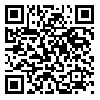شمارۀ جدید فصلنامه (تابستان 1404) منتشر شد
Volume 11, Issue 2 (10-2020)
Social Problems of Iran 2020, 11(2): 125-152 |
Back to browse issues page
Download citation:
BibTeX | RIS | EndNote | Medlars | ProCite | Reference Manager | RefWorks
Send citation to:



BibTeX | RIS | EndNote | Medlars | ProCite | Reference Manager | RefWorks
Send citation to:
Zareivand L, Ghodrati S, Arfaei Moghadam A. (2020). The study of social indifference and related social factors;
Case study: Hakim Sabzevari university students. Social Problems of Iran. 11(2), 125-152.
URL: http://jspi.khu.ac.ir/article-1-2791-en.html
URL: http://jspi.khu.ac.ir/article-1-2791-en.html
1- M.A of Sociology. Hakim Sabzevari University
2- Assistant Professor of Demography. Hakim Sabzevari University ,s.ghodrati@hsu.ac.ir
3- Assistant Professor of Sociology. Hakim Sabzevari University
2- Assistant Professor of Demography. Hakim Sabzevari University ,
3- Assistant Professor of Sociology. Hakim Sabzevari University
Abstract: (6140 Views)
Social indifference is a social issue; In which there is a kind of disconnect between people's awareness, feelings and behavior towards social issues, and this disconnect causes passivity towards social issues. The purpose of this study is to investigate the level of social indifference of students of Hakim Sabzevari University and the factors affecting it. This research was done by survey method and questionnaire technique. The statistical sample was estimated using Cochran's formula 370 people who were selected by stratified random method. The results show that the rate of social indifference of students is moderate and 73.7% they were moderately indifferent. There was no significant difference between contextual variables including gender, place of residence, ethnicity, field and level of education with social indifference; but there is a significant difference between marital status and age with social indifference. The lack of significance of most of the contextual variables indicates the generality of this phenomenon among students, regardless of whether they are male or female, urban or rural, and of different ethnicities. The family context variable was always the most effective in all bivariate and multivariate tests. The sequence of independent variables affecting social indifference based on path analysis were: family background, feeling of social anomaly, social effectiveness, mass media, social trust and hope for the future. The results of regression analysis show that 29% the changes in students' social indifference are explained by independent variables. Thus, despite the fact that various theories were used to explain social indifference, the rate of explanation of the dependent variable was not very high. This may indicate that social indifference among students has unique characteristics that are not addressed in theories.
Type of Article: Original Research |
Received: 2020/01/20 | Accepted: 2020/09/22 | Published: 2021/03/14
Received: 2020/01/20 | Accepted: 2020/09/22 | Published: 2021/03/14
References
1. Alikhah. F. (2005). Measuring the Basic Concepts of Social Sciences, First Print, Cover 1 and 2. Tehran: Culture and Islamic Guidance Ministry.
2. Bakhtiary. M. (2011). The Social Trust and Relationship of Some of Social Factors with it: Case Study Qom City, Cultural Social Studies: 2: 65-92.
3. Banifatemeh,H,.Rasouly. Z. (2012). The study of Social Alienation between Students of Tabriz University and Factors Affecting with it, Applied Sociology: 41:1-26.
4. Davis. Z. (2009). A Phenomenology of Political Apathy: Scheler on the Origins of Mass Violence, Cont Philos Review: 42:149-169.
5. Fouladian. A. (2016). The Study of Relation between Social Alienation and Social Apathy among Islamic Azad University of Mashhad Students, Studies of Youth Sociology Quarterly: 5(17): 125- 144.
6. Ganz Dean. Dwight, A.B. (1956). Alienation and Political Apathy. Ph.D. Thesis. The Ohio State University.
7. Gazizadeh. H,. Kianpoor. M. (2016). The Study of Social Apathy among Students (Case Study: Esfahan University), Guideline Studies of Security and Social Order: 4(1): 59- 78.
8. Ghafary. Gh,. Niazy,M. (2008). Partnership Sociology, Tehran: Nazdik Publication.
9. Handelman. R. (1999). Defining and Assessing Adolescents Apathy .Ph.D. Thesis. University of New York.
10. Hekmat Panah. Sh. (2016). Social Factors Affecting on Social Apathy (Case study: Partition 20-60 Age of Area 1 of Tabriz city in 2017 Year, Master of Science Thesis in Islamic Azad University of Tehran.
11. Kalantari,S,. Adiby,M,.Rabani. R,.Ahmady. S. (2008). The Study of apathy and Altruism in Urban Society of Iran and Factors Affecting it, Behavior Scholar: 14(22): 27- 36.
12. Leo B. Van S,.Peer,S. (1991).Social Class and Political Behavior during a Period of Economic Stagnation: Apathy and Radicalism in the Netherlands, 1985, Political Psychology, Vol. 12, No. 1:41-63.
13. Magsody. B. (2016). The study and Comparison of Social Apathy between Students and Clergy, Master of Science Thesis. Kharazmy University.
14. Masoud Niaa, E. (2002). Sociology Specify of Citizenship Apathy in Social and Political Life, Political; Economic Information: (167 and 168): 152- 165.
15. Michael E. A,. Jacqueline L. Y. (2011). The Effects of Tenure on Staff Apathy and Treatment Orientation: A Comparison of Respondent Characteristics and Environmental Factors .Am J Crim Just: 36:1-16.
16. Mohseni Tabrizy, A,. Sedagati Fard, M. (2012). The Study of Apathy in Iran (Case Study: Tehran Citizens), Applied Sociology: 22(3):1-26.
17. NavaBakhsh,M,.Mirzapouri,J. (2016). A sociological Analysis of Anomaly Impact on Social Apathy (Case of Study: Babol City) , Studies of Iran Social Development: 7(3):53-68.
18. Sedagatifard, M. (2014). Social Apathy (Semantic, Theoretical Foundation, Etiologic), Second Print, Esfahan: Behta Study.
19. Schou. R. (2015). Countering Student Apathy to Increase Student Engagement. Ph.D. Thesis. Wahden University.
20. Sharepour, M. (2013). Urban Sociology, Fifth Print, Tehran: Samt Press.
21. Zahirynia, M,. Golabi, F,. Hedayat eivregh, R. (2016). Identification of Factors Affecting Social Apathy among Mohageg Ardebily University Students, Studies of Iran Social Science: 12(45): 86- 121.
Send email to the article author
| Rights and permissions | |
 |
This work is licensed under a Creative Commons Attribution-NonCommercial 4.0 International License. |







